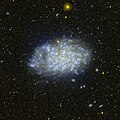NGC 7793
| Galaxy NGC 7793 |
|
|---|---|

|
|
| Recording with the Very Large Telescope of ESO | |
| AladinLite | |
| Constellation | sculptor |
|
Position equinox : J2000.0 , epoch : J2000.0 |
|
| Right ascension | 23 h 57 m 49.83 s |
| declination | -32 ° 35 ′ 27.7 ″ |
| Appearance | |
| Morphological type | SA (s) d / HII |
| Brightness (visual) | 9.0 mag |
| Brightness (B-band) | 9.7 likes |
| Angular expansion | 9.3 ′ × 6.3 ′ |
| Position angle | 98 ° |
| Surface brightness | 13.3 mag / arcmin² |
| Physical data | |
| Affiliation |
Sculptor group SSRS group 49 NGC 55 group LGG 4 |
| Redshift | 0.000767 ± 0.000013 |
| Radial velocity | 230 ± 4 km / s |
|
Stroke distance v rad / H 0 |
(10 ± 1) x 10 6 ly (3.14 ± 0.23) Mpc |
| history | |
| discovery | James Dunlop |
| Discovery date | July 14, 1826 |
| Catalog names | |
| NGC 7793 • PGC 73049 • ESO 349-012 • MCG -06-01-009 • IRAS 23552-3252 • 2MASX J23574982-3235277 • SGC 235515-3252.1 • GC 6233 • 2MASS J23574975-3235276 • HIPASS J2357-32 • LDCE 26 NED009 • WISEA J235749.73-323527.5 | |
NGC 7793 is a spiral galaxy of Hubble type Scd with extensive star formation in the constellation Sculptor at the southern sky . It is estimated to be 10 million light years from the Milky Way and about 30,000 light years in diameter .
It is one of the brightest objects of the Sculptor Galaxy Group , a neighboring galaxy cluster of the Local Group, and is considered a member of the NGC 55 Group ( LGG 4 ).
The type IIP supernova SN 2008bk was observed here.
The object was discovered on July 14, 1826 by the Scottish astronomer James Dunlop .
Microquasar
With the help of the telescopes of the European Southern Observatory, a group of European researchers discovered a microquasar in one of the spiral arms of NGC 7793, which is particularly noticeable due to the particularly violent ejections of matter. The black hole , which forms the center of the microquasar, not only absorbs large amounts of matter, it also accelerates and ejects it in the form of jets . A gas bubble about 1,000 light years in diameter expands at almost 0.1 percent speed of light.
Ultraviolet absorption from GALEX
Infrared image from the Spitzer Space Telescope
High-resolution image from the Hubble Space Telescope of the central area of NGC 7793
Web links
- SIMBAD Astronomical Database
- Aladin Lite
- Capella Observatory
- Antilhue - Chile
- Manfred W. Pakull, Roberto Soria, Christian Motch: A 300-parsec-long jet-inflated bubble around a powerful microquasar in the galaxy NGC 7793. In: Nature. 466, 2010, p. 209, doi : 10.1038 / nature09168 .
- Cosmic Moloch: Black Hole spits jets of gas into space. In: Spiegel Online . July 8, 2010, accessed January 7, 2017 .
- Spektrum .de: amateur recordings [1]



